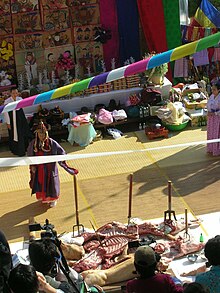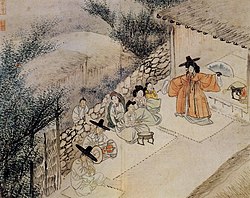
| Part of a series on |
| Korean shamanism |
|---|
 |
Gut (Korean: 굿, also romanised kut or goot) are the rites performed by Korean shamans, involving offerings and sacrifices to gods, spirits and ancestors.[1] They are characterised by rhythmic movements, songs, oracles and prayers.[2] These rites are meant to create welfare, promoting commitment between the spirits and humankind.[1] The major categories of rites are the naerim-gut, the dodang-gut and the ssitgim-gut.
Through song and dance, the shaman begs the gods to intervene in the fortune of humans. The shaman wears a very colourful costume and normally speaks in ecstasy. During a rite, the shaman changes his or her costume several times. Rituals consist of various phases, called gori.[3]
In Jeju Island, gut rituals involve the recitation of a myth about the deities being invoked, called bon-puri. Similar narratives are also found in mainland shamanism.
- ^ a b Lee (1981), p. 27.
- ^ Lee (1981), p. 40.
- ^ Lee (1981), p. 31.